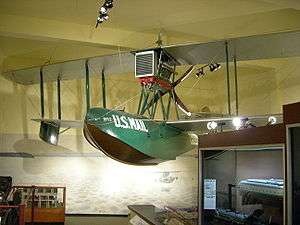Boeing Model 6
| Model 6 | |
|---|---|
 | |
| Model 6 on display at the Museum of History and Industry in Seattle | |
| Role | Utility flying boat |
| Manufacturer | Boeing |
| Designer | William Boeing |
| First flight | 27 December 1919[1] |
| Produced | 1919 - 1927 |
| Number built | 1 |
|
| |
The Boeing Model 6, also known as the B-1 was a small biplane flying boat designed by William Boeing shortly after World War I.
Design and development
The Model 6 was the first commercial design for Boeing (as opposed to military or experimental designs), hence the B-1 designation. Its layout was conventional for its day, with a Hall-Scott engine driving a pusher propeller mounted amongst the cabane struts. The pilot sat in an open cockpit at the bow, and up to two passengers could be carried in a second open cockpit behind the first. The design was reminiscent of the Curtiss HS-2L that Boeing had been building under license during the war.
Operational history
Only a single aircraft was built, as Boeing had trouble selling it in a market flooded with war-surplus aircraft. In 1920, it was purchased by Edward Hubbard, who used it to carry air mail between Seattle, Washington and Victoria, British Columbia. It flew until 1930 before being preserved and put on display at Seattle's Museum of History and Industry in 1954.
Specifications
Data from Bowers,[2] Boeing B-1 Seaplane page[3]
General characteristics
- Crew: one pilot
- Capacity: 2 passengers
- Length: 31 ft 3 in (9.53 m)
- Wingspan: 50 ft 3 in (15.32 m)
- Height: 13 ft 4 in (4.06 m)
- Wing area: 492 ft2 (45.7 m2)
- Empty weight: 2,400 lb (1,089 kg)
- Gross weight: 3,850 lb (1,746 kg)
- Powerplant: 1 × Hall-Scott L-6, 200 hp (149 kW) each
Performance
- Maximum speed: 90 mph (145 km/h)
- Cruise speed: 80 mph (128 km/h)
- Range: 400 miles (640 km)
- Service ceiling: 13,300 ft (4,050 m)
References
- ↑ Bowers, 1989, pg. 48
- ↑ Bowers, 1989, pg. 51
- ↑ Boeing B-1 Seaplane. Boeing. Retrieved 9 February 2008
- Bowers, Peter M. Boeing aircraft since 1916. London: Putnam Aeronautical Books, 1989. ISBN 0-85177-804-6.
- Taylor, Michael J. H. (1989). Jane's Encyclopedia of Aviation. London: Studio Editions. p. 170.
- World Aircraft Information Files. London: Bright Star Publishing. pp. File 890 Sheet 50.
External links
| Wikimedia Commons has media related to Boeing B-1. |
| ||||||||||||||||||